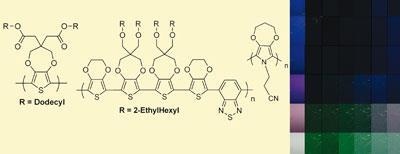New polymer-based material can change from clear to multi-coloured right through to opaque black at the flick of a switch
A new polymer-based material can change from clear to multi-coloured right through to opaque black at the flick of a switch. The electrochromic material could find some interesting applications, such as multi-coloured information displays, electronic books and colour changing mirrors.
Electrochromic compounds are those which can change colour in response to electrical signals, but they have previously come with a high price tag and slim range of available colours. Now, John Reynolds and his team at the University of Florida, US, have developed a cheap polymer-based solution to generate a spectrum of purples and greens, going all the way up to black.
This was achieved by spraying two thin layers of polymer on glass slides, then placing them on top of each other. Each layer is made from a different electrochromic polymer, based on the structure of poly(3,4propylenedioxythiophene). In their neutral state one is dark green and the other is dark purple, making a black colour when overlaid.

Electrical charge can be passed through the device to reversibly oxidise and reduce the polymers - instantly switching between transparent and opaque. By varying the charge used, a range of shades from lime green to dark blue can be obtained.
The team then integrated a third polymer that switches between opaque white and clear into the device. This allowsthe device to flick between black and white - something that is important for the design of thin and flexible optical displays - such as electronic paper that can display information without the need for a backlight.
In the future, the team hope to extend this work to include other colour palettes, as well as miniaturising the device into smaller panels. Devices could also be integrated with light sensors to make ’smart glass’ that responds to flashes or is programmed to lighten or darken at set times.
’This is a useful breakthrough,’ says Roger Mortimer, an expert in electrochromic materials at the Loughborough University, UK. ’Using polymers instead of metal oxides has many advantages - they are flexible but also spray-processable, which makes devices relatively cheap.’
Lewis Brindley
References
E Unur et al, Chem. Mater., DOI: 10.1021/cm902069k






No comments yet